 High-quality,well-fitted carpets make a world of difference to a restoration classic, especially if they replace ones that have been left to rot for a few decades or more.
High-quality,well-fitted carpets make a world of difference to a restoration classic, especially if they replace ones that have been left to rot for a few decades or more.
Most restorers have no doubt when they are putting their budget together that they will be replacing the floor coverings in the project car- the only questions are how, with what and how much.
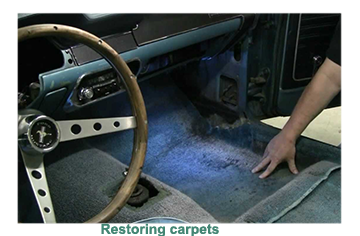 A few get lucky and discover that their carpets are in a salvageable condition and will be brought back to life with a good and thorough cleaning.
A few get lucky and discover that their carpets are in a salvageable condition and will be brought back to life with a good and thorough cleaning.
The restorer can take strength in knowing that carpets are much easier to clean than upholstery and other interior trim parts.
 The first step in cleaning carpets is to beg or borrow ( and preferably not steal) a powerful commercial wet/dry vacuum cleaner, which will do a remarkably effective job in removing the accumulations of dirt and debris in the carpets, as well as loosening up the pile to give the carpet a fresher appearance.
The first step in cleaning carpets is to beg or borrow ( and preferably not steal) a powerful commercial wet/dry vacuum cleaner, which will do a remarkably effective job in removing the accumulations of dirt and debris in the carpets, as well as loosening up the pile to give the carpet a fresher appearance.
The next stage is to scrub down the carpets, not too powerfully using a foam inducing detergent mixed with lukewarm carpet.
Once the carpet has been cleaned, it must be immediately dried out using the vacuum cleaner, followed by another pass with dry towels.
![]()
To complete the job, if there is an air compressor on hand, the carpet pile can be “ fluffed up” using compressed air.
The next stage is to search for stains with the carpets looking as clean as they are likely to be. Unless they are unfriendly, like coffee, nail varnish or even blood, they can usually be removed using the tried and tested formula of Baking Soda and Vinegar.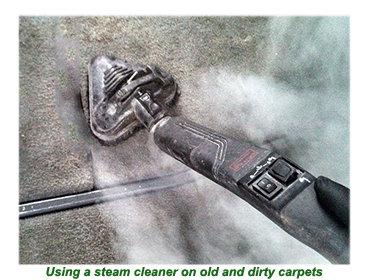
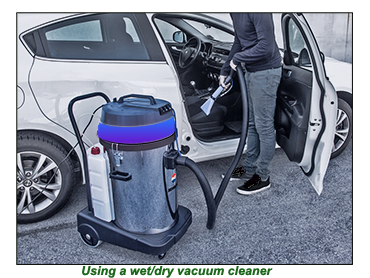 The first step in the spot removal process is to apply a layer of dry baking soda over the problem area, immediately followed by a moderate quantity of white vinegar, diluted with water and a dash of washing up liquid mixed in a spray bottle.
When sprayed on the baking soda, this concoction will begin a chemical reaction that should see must stains disappear within a few hours, after which they should all be removed.
If the carpets are heavily stained, there is the option of hiring a steam cleaner.
The first step in the spot removal process is to apply a layer of dry baking soda over the problem area, immediately followed by a moderate quantity of white vinegar, diluted with water and a dash of washing up liquid mixed in a spray bottle.
When sprayed on the baking soda, this concoction will begin a chemical reaction that should see must stains disappear within a few hours, after which they should all be removed.
If the carpets are heavily stained, there is the option of hiring a steam cleaner.
Steam cleaners have become popular in recent years, regarded as a safe and effective alternative to using chemicals for cleaning carpets ( and upholstery).
Whatever methods that are decided upon to save existing carpets in a classic car should be followed – but not at all costs.
![]()
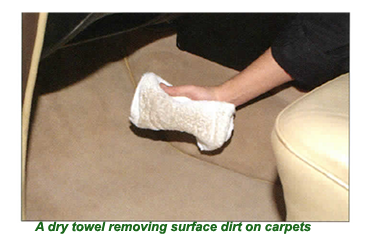 Time is money, and hours spent trying to flog a dead horse ( or a dead carpet ) will be better spent on something else.
Time is money, and hours spent trying to flog a dead horse ( or a dead carpet ) will be better spent on something else.
The same thinking might be applied if the carpets have been ripped or torn over the years. If the rip has occurred in and around a seam or is not too large, then it is far from a lost cause.
If a few rugs are left over that matched the original carpets, it is even possible to cut patch them in place.
If done correctly, the patch will be visible only to the practiced eye.
 All that is required to do the job is a Stanley knife, some heat activated carpet tape and a steam iron.
All that is required to do the job is a Stanley knife, some heat activated carpet tape and a steam iron.
The patch needs to be cut precisely to size and joined to the existing carpet using the carpet tape.
A lot of classic car restoration budget can be saved if this works out.
If, however, the carpet has been badly cut or well worn, there remains only one option - to replace them .
Costs for re-carpeting the floor of even the largest family saloon will not be prohibitive.
Fitting high-quality carpets will make a world of difference to a restoration classic, especially if they replace ones that have been literally trampled underfoot over several decades and possibly left lying to rot for a few decades more.
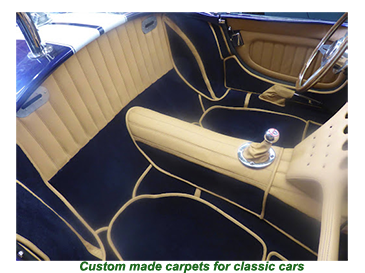 Most restorers have no doubt when they are putting their budget together to replace the floor coverings in the project car- the only questions are how, with what and how much.
Most restorers have no doubt when they are putting their budget together to replace the floor coverings in the project car- the only questions are how, with what and how much.
Replacing carpets in a classic requires little or no technical skills as there are no moving parts involved. All that is required is guile and tenacity to carpet a classic, with the cost savings considerable if the restorer decides to tackle the job in-house.
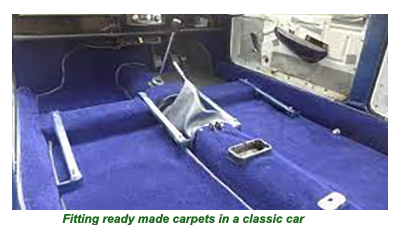 >Many restorers choose to take the easy way out , although it is not guaranteed to provide the best of results. That is to order a set of ready-made carpets specifically cut to size to match manufacturer’s template for the particular model. If the vehicle being restored is an obscure variety, this option may not even be available.
>Many restorers choose to take the easy way out , although it is not guaranteed to provide the best of results. That is to order a set of ready-made carpets specifically cut to size to match manufacturer’s template for the particular model. If the vehicle being restored is an obscure variety, this option may not even be available.
cu2


